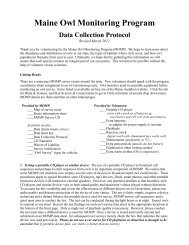Focus Species Forestry - Maine Audubon
Focus Species Forestry - Maine Audubon
Focus Species Forestry - Maine Audubon
You also want an ePaper? Increase the reach of your titles
YUMPU automatically turns print PDFs into web optimized ePapers that Google loves.
Northern Redback Salamander<br />
Distribution: Nova Scotia to eastern Minnesota, south to Kentucky and<br />
the Smoky Mountains<br />
<strong>Maine</strong> <strong>Focus</strong> Region: Statewide<br />
Home Range/Movement: Up to 260 sq. ft., individuals often recaptured<br />
under the same rock or log<br />
Food: Carnivorous, feeds on insects and other invertebrates found in the<br />
leaf litter<br />
Special Habitat Needs: Forests with well developed leaf litter layer and<br />
woody debris<br />
Management:<br />
Uneven-aged management or even-aged stands over 50-60 years<br />
old provide the best redback habitat.<br />
Comments: Look for this small (2-4 in.) salamander under branches, logs, or brush piles. The redback phase has<br />
dark sides and a red-brown dorsal stripe, while the “leadback” color phase is typically dark gray or brown<br />
throughout. Studies in New Hampshire found that the total biomass of redback salamanders was about twice that of<br />
breeding birds and equal to that of mice and shrews. By preying on soil organisms, redbacks probably play an<br />
important role in regulating decomposition of organic matter and are an important food source for other animals.<br />
Habitat Use:<br />
Aspen-Birch<br />
Forest Ecosystems<br />
Northern<br />
Hardwoods Oak-Pine Hemlock Spruce-Fir<br />
N. White<br />
Cedar<br />
R S I M R S I M L R S I M L I M L R S I M L I M L<br />
Special-value<br />
Habitats<br />
Riparian/<br />
Wetland Vernal<br />
Forest Pool<br />
R Regeneration and seedlings Mx Mixed conifer-deciduous <strong>Focus</strong> habitat<br />
S Saplings and small poles U Understory present Other habitat<br />
I Intermediate-aged forest C Cavity tree or snag Little/no use<br />
M Mature forest<br />
L Late-successional forest<br />
References: Boone and Krohn 1998, DeGraaf and Yamasaki 2001, Witham 1999<br />
54<br />
<strong>Focus</strong> <strong>Species</strong> <strong>Forestry</strong>



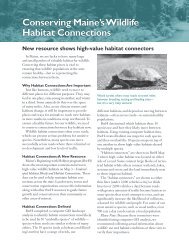
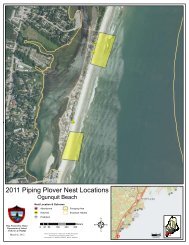
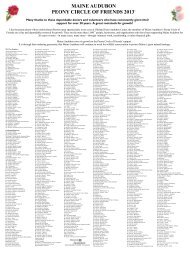
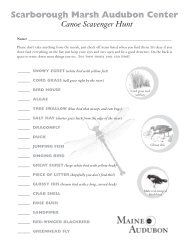

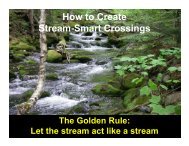
![2012 Loon Count Results [pdf] - Maine Audubon](https://img.yumpu.com/26228732/1/190x245/2012-loon-count-results-pdf-maine-audubon.jpg?quality=85)
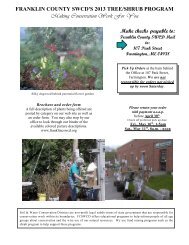
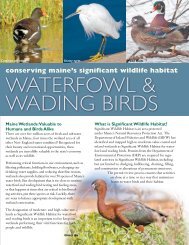
![Lake Fish of Maine (DIFW list) [pdf] - Maine Audubon](https://img.yumpu.com/23282964/1/190x245/lake-fish-of-maine-difw-list-pdf-maine-audubon.jpg?quality=85)
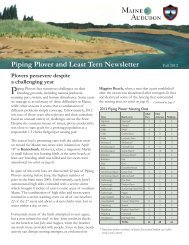

![The Maine Audubon Peony Circle of Friends 2012 [pdf]](https://img.yumpu.com/22707677/1/190x253/the-maine-audubon-peony-circle-of-friends-2012-pdf.jpg?quality=85)
